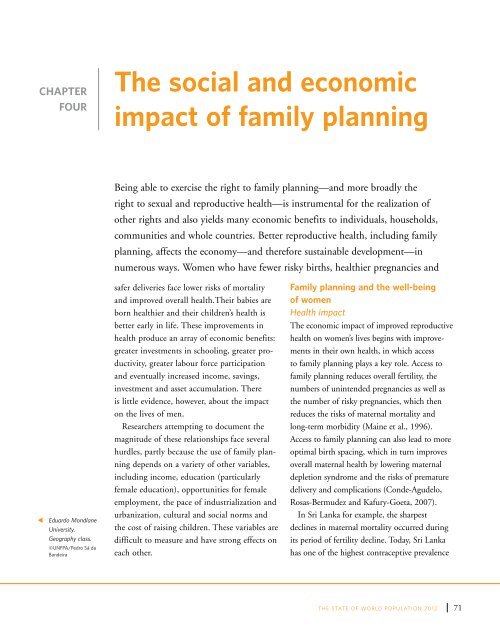State of World Population 2012 - Country Page List - UNFPA
State of World Population 2012 - Country Page List - UNFPA
State of World Population 2012 - Country Page List - UNFPA
Create successful ePaper yourself
Turn your PDF publications into a flip-book with our unique Google optimized e-Paper software.
CHAPTER<br />
FOUR<br />
The social and economic<br />
impact <strong>of</strong> family planning<br />
Being able to exercise the right to family planning—and more broadly the<br />
right to sexual and reproductive health—is instrumental for the realization <strong>of</strong><br />
other rights and also yields many economic benefits to individuals, households,<br />
communities and whole countries. Better reproductive health, including family<br />
planning, affects the economy—and therefore sustainable development—in<br />
numerous ways. Women who have fewer risky births, healthier pregnancies and<br />
t<br />
Eduardo Mondlane<br />
University.<br />
Geography class.<br />
©<strong>UNFPA</strong>/Pedro Sá da<br />
Bandeira<br />
safer deliveries face lower risks <strong>of</strong> mortality<br />
and improved overall health.Their babies are<br />
born healthier and their children’s health is<br />
better early in life. These improvements in<br />
health produce an array <strong>of</strong> economic benefits:<br />
greater investments in schooling, greater productivity,<br />
greater labour force participation<br />
and eventually increased income, savings,<br />
investment and asset accumulation. There<br />
is little evidence, however, about the impact<br />
on the lives <strong>of</strong> men.<br />
Researchers attempting to document the<br />
magnitude <strong>of</strong> these relationships face several<br />
hurdles, partly because the use <strong>of</strong> family planning<br />
depends on a variety <strong>of</strong> other variables,<br />
including income, education (particularly<br />
female education), opportunities for female<br />
employment, the pace <strong>of</strong> industrialization and<br />
urbanization, cultural and social norms and<br />
the cost <strong>of</strong> raising children. These variables are<br />
difficult to measure and have strong effects on<br />
each other.<br />
Family planning and the well-being<br />
<strong>of</strong> women<br />
Health impact<br />
The economic impact <strong>of</strong> improved reproductive<br />
health on women’s lives begins with improvements<br />
in their own health, in which access<br />
to family planning plays a key role. Access to<br />
family planning reduces overall fertility, the<br />
numbers <strong>of</strong> unintended pregnancies as well as<br />
the number <strong>of</strong> risky pregnancies, which then<br />
reduces the risks <strong>of</strong> maternal mortality and<br />
long-term morbidity (Maine et al., 1996).<br />
Access to family planning can also lead to more<br />
optimal birth spacing, which in turn improves<br />
overall maternal health by lowering maternal<br />
depletion syndrome and the risks <strong>of</strong> premature<br />
delivery and complications (Conde-Agudelo,<br />
Rosas-Bermudez and Kafury-Goeta, 2007).<br />
In Sri Lanka for example, the sharpest<br />
declines in maternal mortality occurred during<br />
its period <strong>of</strong> fertility decline. Today, Sri Lanka<br />
has one <strong>of</strong> the highest contraceptive prevalence<br />
THE STATE OF WORLD POPULATION <strong>2012</strong><br />
71
















